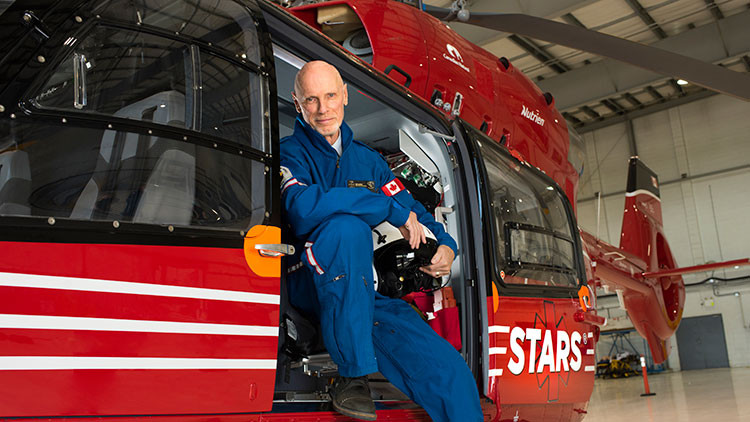Government mail service may be affected by the Canada Post labour disruption. Learn about how critical government mail will be handled.

"Recognize the seeds that are planted as you journey through your life, because you never know when you’re going to reach back in your memory and pull together an idea, a concept and make it happen – all because you paid attention to what was going on around you when you were young."
Dr. Gregory Powell has devoted much of his professional life to providing Albertans with better emergency care and is recognized as a visionary leader and innovator in emergency air medicine. He co-founded the Shock Trauma Air Rescue Service (STARS) and pioneered the use of advanced communications, life-saving technologies, and specialized aeromedical crew training. He was instrumental in the transformation of emergency medical care in Canada by advocating for and contributing to the national development of physician specialty training in emergency medicine.
Dwight Gregory Powell was born on November 24, 1947, in Welland, Ontario, the oldest of three children. When Greg was six months old, his family relocated to Alberta because his father, a civil engineer, accepted a job offer in the oil industry. Greg grew up in Edmonton but spent his summers and every waking moment possible on his relatives’ farm west of Blackfalds driving tractors, herding cattle and riding his horse.
Still, there was never much doubt about his career path. As Greg remembers, “My mother told me that when Christmas came around every year, I would ask for a doctor’s bag. In those days, your kit included a plastic otoscope and a stethoscope. The best part was the little box of sugar pills you could dispense to make people feel better.”
After graduating from Strathcona Composite High School in Edmonton, Greg studied medicine at the University of British Columbia. As a second-year med student, he decided to use his medical elective time to join the Flying Doctor Service in Darwin, Australia. Enroute there, Greg was given the opportunity to visit a MASH (mobile army surgical hospital) unit, located in then Saigon, during the Vietnam conflict.
There he saw war casualties steadily arriving by helicopter, going straight from the field to an operating room. “I knew back home that those with this level of trauma would not have lived. They had very serious injuries, yet because they were moved so quickly with so much talent from the battlefield to the hands of the surgeon, they survived.” A seed was planted, one that would sprout almost 20 years later.
After finishing his medical degree at UBC, Greg completed his family medicine training in Calgary before heading to McGill University – at the time Canada’s only emergency medicine training program.
Upon returning to Foothills Hospital in the late 1970s as Director, Emergency Medicine, and the only formally trained emergency physician in the city, he collaborated with the University of Calgary to plan and launch the Emergency Medicine Residency training program.
In the early 1980s, he contributed to the formation of the Canadian Association of Emergency Physicians. With the support of medical organizations and in collaboration with the Royal College of Physicians and Surgeons, and the College of Family Physicians of Canada, he and his colleagues participated in setting exams, creating a board of examiners and building the Canadian emergency medicine specialty. Alongside a small group of doctors, Greg criss-crossed the country to nudge major universities to establish programs in emergency medicine.
However, memories of his trip to Vietnam lingered. Now an emergency physician with years of experience, he had seen many patients die despite having survivable medical conditions and trauma, because they hadn’t been able to get to a tertiary care hospital fast enough.
Always intensely interested in aviation, Greg had obtained his pilot’s license at age 26. The creation of STARS evolved and another seed grew, using helicopters as the primary transportation, staffed with highly trained medical crews.
STARS’ early years were not easy. A government program that provided reimbursements for flights carrying patients didn’t yield enough financial support. Despite donations from the Lions Club and the helicopter’s manufacturer, the financial shortfall grew.
But Greg refused to give up. He firmly believed that purpose, passion and persistence would save the day – and so would the community. Residents of rural areas in the province saw what STARS was doing and stories spread about lives saved with the provision of advanced medical care and the rapid response by a familiar red helicopter.
A year or two after starting operations, Greg received an invitation to an event in the town of Hanna. Upon arriving, he was amazed to experience a community fundraiser for STARS, which raised significant support over the ensuing few years.
With that event and insight came a new understanding about STARS’ mission: “We’re not going to change the epidemiology of heart disease in small communities. It’s not about that. It’s about the public health safety net. It’s about knowing that people care. It’s about being proud to live in your community.” Another path opened to raise funds to keep the chopper in the air. The STARS Foundation was formed. Greg and his wife Linda began travelling across southern Alberta, with many volunteers, to attend similar events.
It didn’t take long for the medical community to see that survival rates for seriously ill patients in the south, where STARS then operated, were improving. Requests for STARS to expand began to come in. With promises of increased support from the tertiary care hospitals and the energy sector, STARS moved beyond Calgary, opening an Edmonton base in 1991 and one in Grande Prairie in 2006. With requests from Saskatchewan and Manitoba, bases in Regina, Saskatoon and Winnipeg followed in 2011-2012.
Greg’s vision for rapid, safe and advanced aeromedical care led to pioneering new methods to deliver and support medical care, including helicopter night vision goggle technology and the transport of blood products. The development of heliports at urban and rural hospitals and outreach training for rural health care providers flourished, enhancing the delivery of care to remote and rural communities.
In the early 1990s, STARS established the unique STARS Emergency Link Centre – a 24-hour communications facility to manage the rapid medical referral, triage and transport of critical patients between rural health care providers and urban hospital specialists. STARS also created a rural work-site registration system for the energy sector. This system brings together GPS coordinates, landing sites for helicopters and personnel training, allowing injured workers to be safely evacuated from isolated areas.
Convinced that excellent critical care is a matter of time and access to talent, Greg has poured his energy into preparing and mentoring the next generation. This has included establishing a critical care transport academy for doctors, nurses and paramedics, and overseeing the creation of the first mobile medical human patient simulation training program in North America to provide the intensive clinical practice and learning environment for both STARS medical crew and rural medical care professionals.
Greg’s expertise has been recognized through his appointment as Chair of Emergency Medical Services for the 1988 Calgary Winter Olympics, as Medical Director for Internationally Protected Persons at the 2002 G8 Summit in Kananaskis, as a past president of the Association of Air Medical Services, and as an early director of MedEvac Foundation International, which is dedicated to research and education in air medical transport.
Greg has also received numerous distinctions including the Alberta Centennial Medal in 2005, recognition as one of Alberta’s Physicians of the Century by the Alberta Medical Association and College of Physicians and Surgeons of Alberta in 2006, the Order of Canada in 2006 and the Queen Elizabeth II’s Diamond Jubilee Medal in 2012. In 2015, the Foothills Medical Centre helipad was named after him. In 2018, Greg was inducted into the Canadian Aviation Hall of Fame.
Although he retired as STARS President and CEO in 2012, Greg’s dedication to ensuring all Canadians receive equal access to outstanding medical care is undiminished. After such a fulfilling career and contributing to medical care for the critically ill and injured, he aims to pay it forward.
Together, Greg and Linda are now actively involved in advocacy and public awareness to enhance organ and tissue donation and transplantation in Alberta. This commitment is influenced by Greg’s diagnosis of liver disease caused by Hepatitis C from a tainted blood transfusion in the 1980s.
Greg has served as a board member with many organizations, currently serving on the Health Quality Council of Alberta and the Foothills Country Hospice.
Greg and Linda live in the Foothills area, enjoying rural life, family and community time. They have three adult children and a grandson.
